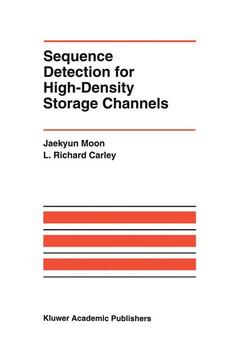Sequence Detection for High-Density Storage Channels, Softcover reprint of the original 1st ed. 1992 The Springer International Series in Engineering and Computer Science Series, Vol. 187
Langue : Anglais
Auteurs : Moon Jaekyun, Carley L. Richard

Magnetic data storage can be viewed as a data communication system. This is not a sUlprising view, considering that data storage is essentially the transfer of data between different times. The past decade has indeed seen rapidly growing interest in applying improved coding and detection techniques to magnetic data storage, a traditional approach to enhance performance of communication channels. Since its inception in the 1930's, the magnetic recording industry has achieved impressive progress in data capacity. This has been made possible mainly by innovations and advances in heads and media design. However, as the demand for higher storage capacity continues in the modem information era, a need arises to explore other possibilities to help meet the ever-growing demand. Advanced coding and detection are one such possibility, providing an efficient, cost-effective means to increase data capacity. In fact, with the advent of modem Ie technology which has enabled real-time implementation of increasingly complex signal processing algorithms, advanced coding and detection are rapidly becoming a major issue in the development of improved data storage products. While there have been remarkable advances in recent years in the areas of both coding and detection for data storage, this book focuses only on data detection, or the processing of readback waveforms to reproduce stored data, in conjunction with the traditional modulation coding method called run length-limited or (d,k) coding.
1. Introduction.- 1.1. Motivation.- 1.2. Background.- 2. Fixed-Delay Tree Search.- 2.1. Derivation.- 2.2. Computational Efficiency.- 2.3. Performance Analysis.- 2.4. Effect of d-constraint on Performance.- 2.5. Effect of d-constraint on Complexity.- 2.6. Summary and Conclusions.- 3. Application to Digital Magnetic Recording.- 3.1. Channel Model.- 3.2. Detection Schemes.- 3.3. Performance Comparison.- 3.4. Summary and Conclusions.- 4. Effects of Transition Noise.- 4.1. Channel Model.- 4.2. Detection Performance.- 4.3. Channel Shaping.- 4.4. Numerical Examples.- 4.5. Summary.- 5. Summary.- References.
Date de parution : 09-2012
Ouvrage de 153 p.
15.5x23.5 cm
Thème de Sequence Detection for High-Density Storage Channels :
Mots-clés :
Modulation; Symbol; algorithm; coding; communication; complexity; detection; model
© 2024 LAVOISIER S.A.S.



